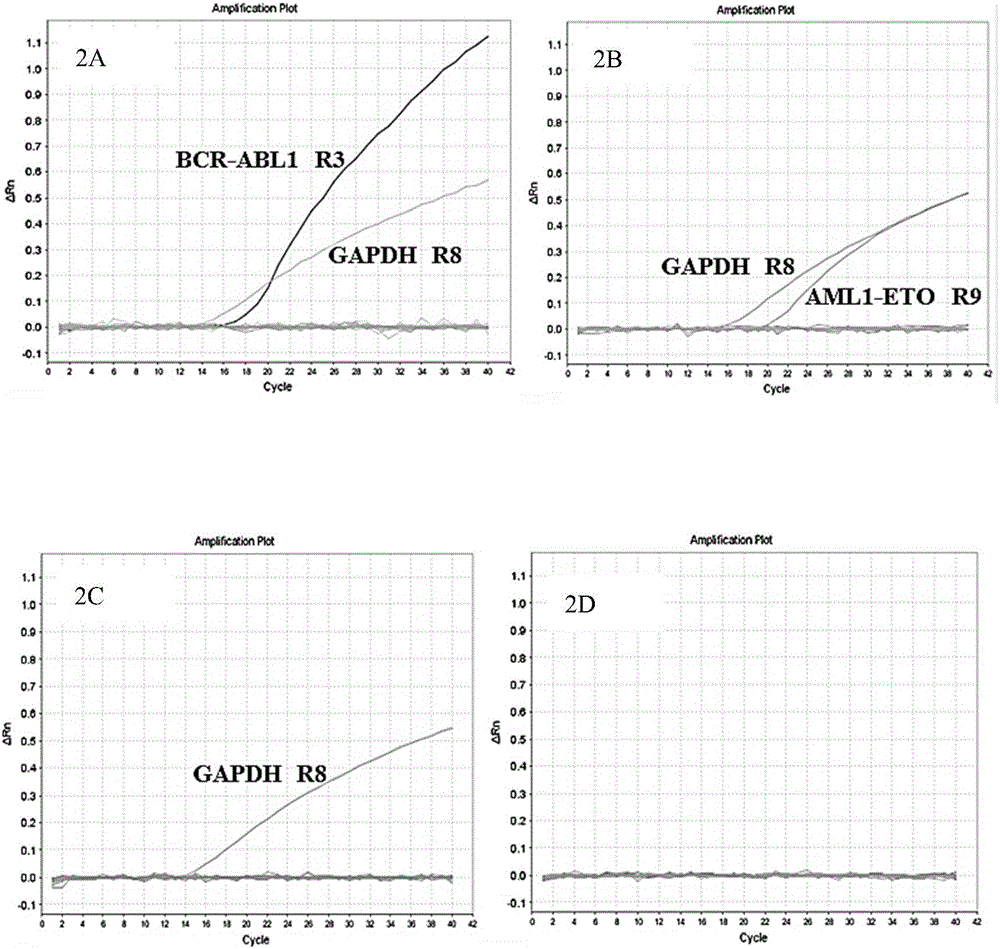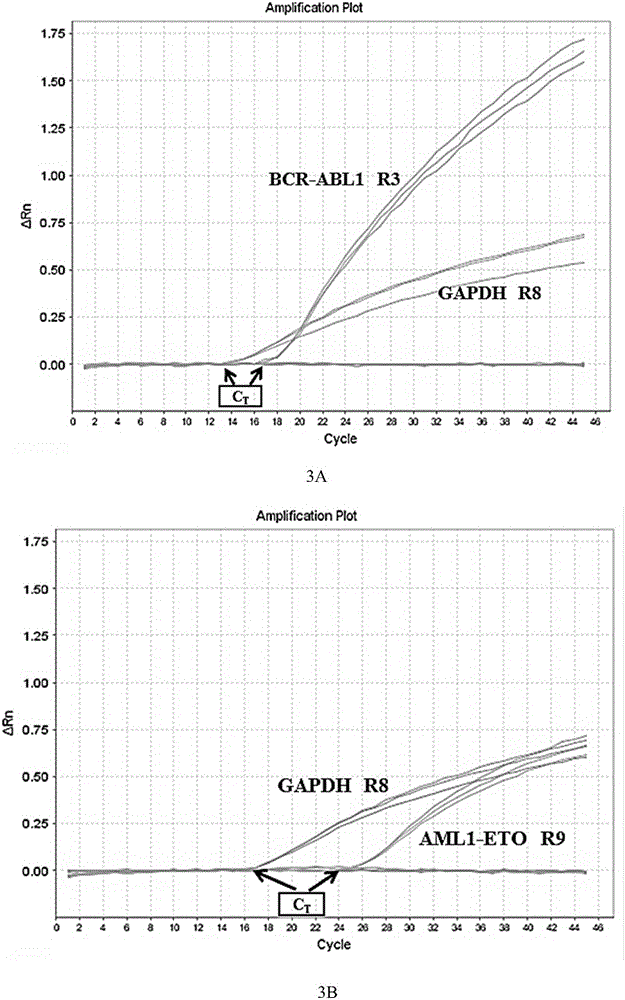Primer, probe, kit and method for qualitatively detecting fusion genes of leukemia
A fusion gene and leukemia technology, applied in the field of genetic engineering, can solve the problems of inability to amplify specific target products, reduce the specificity and efficiency of PCR reactions, increase the interaction of multiple pairs of primers and multiple probes, and form dimers Probability and other issues, to achieve shortened detection time, high sensitivity and specificity, and reduce false positive effects
- Summary
- Abstract
- Description
- Claims
- Application Information
AI Technical Summary
Problems solved by technology
Method used
Image
Examples
Embodiment 1
[0044] Embodiment 1: Utilize fusion gene positive cell line and negative cell line to detect the specificity of detection system of the present invention
[0045] In this embodiment, the feasibility and specificity of the detection method of the present invention are verified by determining the K562 positive cell line containing the BCR-ABL1 (p210) fusion gene, the Kasumi cell line of the AML1-ETO fusion gene, and the HL60 negative cell line without the fusion gene sex. Among them, K562 cell line, Kasumi cell line, and HL60 cell line were all purchased from Beijing Dingguo Changsheng Biotechnology Co., Ltd.
[0046] The specific detection method of the present embodiment is as follows:
[0047] 1. Cell culture
[0048] Cultivate K562 cell line, Kasumi cell line and HL60 cell line according to the standard operation of cell culture at 37°C, 5% CO 2 Cultured in an incubator.
[0049] 2. Nucleic acid extraction
[0050] It is recommended to use TIANGEN RNAprep Pure Blood Kit...
Embodiment 2
[0064] Example 2: Using fusion gene positive cell lines to detect the repeatability of the detection system of the present invention
[0065] In this embodiment, the repeatability of the detection system of the present invention is also verified by determining the K562 positive cell line containing the BCR-ABL1 fusion gene and the Kasumi cell line containing the AML1-ETO fusion gene.
[0066] The specific detection method is as follows:
[0067] Using the same multiple fluorescent RT-PCR reaction system and reaction conditions as in Example 1, using K562cDNA and Kasumi cDNA as templates, each sample was repeatedly detected three times, and the fluorescent PCR amplification curve for repeatability detection can be found in the appendix of the instructions. image 3 . in image 3 A is the fusion gene detection result of K562 positive cell line, image 3 B is the fusion gene detection result of Kasumi positive cell line. Such as image 3 As shown in A, the positive cell line...
Embodiment 3
[0068] Embodiment 3: Utilize fusion gene positive cell line and negative cell line to detect the sensitivity of detection system of the present invention
[0069] This embodiment also verifies the sensitivity of the detection system of the present invention by determining the K562 positive cell line containing the BCR-ABL1 (p210) fusion gene, the Kasumi cell line containing the AML1-ETO fusion gene, and the HL60 negative cell line without the fusion gene. The specific detection method is as follows:
[0070] K562 cell line (positive cell line containing BCR-ABL1 fusion gene) and Kasumi cell line (positive cell line containing AML-ETO fusion gene) were carried out with HL-60 cell line (negative cell line without fusion gene) respectively. Dilution of 100%, 10%, 1%, 1‰, 0.5‰, 0.25‰, 0.125‰ (the ratio of positive cell line to negative cell line after dilution), extract RNA with diluted mixed cell line and reverse transcribe into cDNA , for multiplex fluorescent RT-PCR detection....
PUM
 Login to View More
Login to View More Abstract
Description
Claims
Application Information
 Login to View More
Login to View More - R&D
- Intellectual Property
- Life Sciences
- Materials
- Tech Scout
- Unparalleled Data Quality
- Higher Quality Content
- 60% Fewer Hallucinations
Browse by: Latest US Patents, China's latest patents, Technical Efficacy Thesaurus, Application Domain, Technology Topic, Popular Technical Reports.
© 2025 PatSnap. All rights reserved.Legal|Privacy policy|Modern Slavery Act Transparency Statement|Sitemap|About US| Contact US: help@patsnap.com



